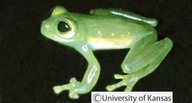|
Teratohyla midas (Lynch & Duellman, 1973)
Midas’ Glassfrog, Rana de Cristal Midas | family: Centrolenidae subfamily: Centroleninae genus: Teratohyla |
| Species Description: Lynch, J.D. and Duellman, W.E. (1973). "A review of the centrolenid frogs of Ecuador, with descriptions of new species." Occasional Papers of the Musem of Natural History, University of Kansas, (16), 1-66 | |
 © 2010 Division of Herpetology, University of Kansas (1 of 7) |
|
|
|
Description Teratohyla midas looks similar to Rulyrana flavopunctata, but it is differentiated from R. flavopunctata by a truncate instead of rounded snout, and by having less webbing on its hands and feet. It also looks similar to Nymphargus siren, but it is differentiated from N. siren by having a less prominent tympanum that points towards the sides and the back instead of towards the sides and the posterior, and it has more webbing on its hands and feet (Lynch and Duellman 1973). In life, the entire backside is dark green with some gold fleck colorations on its sides, and has a white chest. The lining of the abdominal cavity is unpigmented, and it has green bones. The iris is silvery bronze with a black-netted pattern, and the hands and feet are a pale yellow-green color. In preservative, its entire backside is lavender with some white fleck colorations on its body. The rest of its body is creamy white (Lynch and Duellman 1973). There is no information available on variation within the species. Distribution and Habitat Country distribution from AmphibiaWeb's database: Brazil, Ecuador, French Guiana, Peru
Life History, Abundance, Activity, and Special Behaviors Trends and Threats Relation to Humans Possible reasons for amphibian decline General habitat alteration and loss Comments The species name midas refers to a king in Greek mythology, who turned everything he touched into gold. This is a reference to the frog being found in Rio Aguarico, where gold has been found, and also a reference to the gold fleck coloration found on the frog (Lynch and Duellman 1973).
References
Cisneros-Heredia, D. F., and McDiarmid, R. W. (2005). ''Amphibia, Centrolenidae, Centrolene peristictum, Centrolene prosoblepon, Cochranella cochranae, Cochranella midas, Cochranella resplendens, Cochranella spinosa, Hyalinobatrachium munozorum: range extensions and new provincial records.'' Check List. Journal of Species Lists and Distribution, 1, 18-22. Guayasamin, J. M., Castroviejo-Fisher, S., Trueb, L., Ayarzaguena, J., Rada, M., Vila, C. (2009). ''Phylogenetic systematics of glassfrogs (Amphibia: Centrolenidae) and their sister taxon Allophryne ruthveni.'' Zootaxa, 2100, 1-97. Lynch, J.D. and Duellman, W.E. (1973). ''A review of the centrolenid frogs of Ecuador, with descriptions of new species.'' Occasional Papers of the Musem of Natural History, University of Kansas, (16), 1-66. Rodriguez, L., Martinez, J. L., Azevedo-Ramos, C., Coloma, L. A., Ron, S. 2004. Teratohyla midas. IUCN Red List of Threatened Species. Version 2012.2. www.iucnredlist.org. Downloaded on 07 February 2013. Originally submitted by: Amanda Chiachi and Gordon Lau (first posted 2015-07-15) Edited by: Ann T. Chang (2021-10-03) Species Account Citation: AmphibiaWeb 2021 Teratohyla midas: Midas’ Glassfrog <https://amphibiaweb.org/species/1777> University of California, Berkeley, CA, USA. Accessed Nov 19, 2024.
Feedback or comments about this page.
Citation: AmphibiaWeb. 2024. <https://amphibiaweb.org> University of California, Berkeley, CA, USA. Accessed 19 Nov 2024. AmphibiaWeb's policy on data use. |



 Map of Life
Map of Life